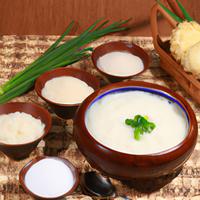
1 serving (150 grams) contains 150 calories, 2.5 grams of protein, 0.2 grams of fat, and 33.0 grams of carbohydrates.

Log this food in SnapCalorie

Nutrition Information
Calories |
238.1 | ||
|---|---|---|---|
% Daily Value* |
|||
| Total Fat | 0.3 g | 0% | |
| Saturated Fat | 0.1 g | 0% | |
| Polyunsaturated Fat | 0 g | ||
| Cholesterol | 0 mg | 0% | |
| Sodium | 7.9 mg | 0% | |
| Total Carbohydrates | 52.4 g | 19% | |
| Dietary Fiber | 0.5 g | 1% | |
| Sugars | 0.2 g | ||
| protein | 4.0 g | 8% | |
| Vitamin D | 0 mcg | 0% | |
| Calcium | 15.9 mg | 1% | |
| Iron | 0.3 mg | 1% | |
| Potassium | 31.7 mg | 0% | |
* Percent Daily Values are based on a 2,000 calorie diet. Your daily values may be higher or lower depending on your calorie needs.
Food Attributes
Source of Calories
About White rice porridge
White rice porridge, also known as congee in many Asian cuisines, is a simple, comforting dish made by boiling white rice with water or broth until it reaches a thick, creamy consistency. Originating from countries like China, Japan, Korea, and Thailand, it serves as a staple breakfast or medicinal food in various cultures. This dish is often customized with toppings such as meats, vegetables, or eggs, making it versatile and adaptable. While white rice porridge is gentle on digestion and hydrating, its low fiber and high glycemic index may not be ideal for everyone, particularly those managing blood sugar levels. Nutritional value depends heavily on added ingredients, which can boost protein, vitamins, and minerals. As a mild, soothing food, it’s frequently eaten during illness or served to those with sensitive stomachs, emphasizing its role in restorative diets worldwide.



